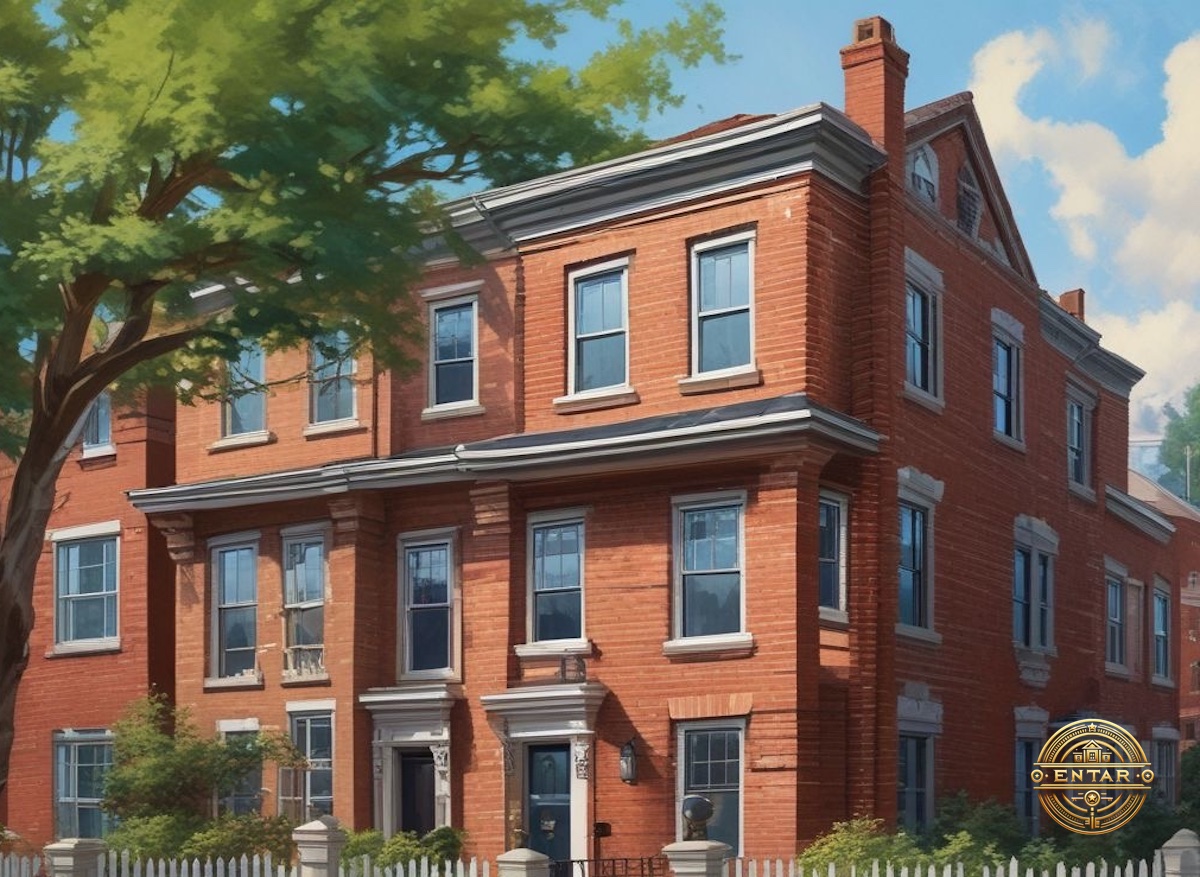Unveiling the Charm of Mills Act Homes in California
Nestled amidst the vibrant landscape of California, Mills Act historic homes are more than mere structures; they are time capsules of architectural splendor and stories untold. Imagine a home where every brick, window, and doorway whispers tales from a bygone era. This is the world of Mills Act properties – a unique segment in California’s real estate market, blending the allure of history with contemporary living.
The Mills Act, a legislative act passed in California, does more than just offer a financial incentive to preserve these historical gems; it serves as a bridge between the past and the present. Here, owners are not just residents; they are guardians of history, curators of stories that have shaped the neighborhoods of California. These homes come with a responsibility – to protect and maintain their architectural integrity for future generations to witness and admire.
Consider the tale of the Thompson House in San Francisco, a Victorian masterpiece that stands as a testament to the city’s rich past. Its journey from a forgotten relic to a restored marvel was made possible by the Mills Act. The current owners, who restored the property to its original glory, not only revived a piece of history but also benefited from significant tax reductions, a hallmark of the Mills Act program.
As we delve into the intricacies of selling a Mills Act historic home, remember, it’s more than a transaction. It’s about passing on a legacy, a piece of California’s cultural tapestry, to those who value the past as much as the future. Let this guide be your compass in navigating the unique and rewarding journey of selling a Mills Act home.
Understanding the Mills Act: Preserving California’s Architectural Heritage
In the heart of California’s bustling cities and quaint towns lie architectural marvels that tell the story of the state’s rich history. Preserving these treasures is the mission of the Mills Act, a unique piece of legislation that stands as a guardian of California’s architectural heritage. To understand the Mills Act is to delve into a world where history, economics, and preservation intersect in fascinating ways.
A Journey Through Time: The Origin of the Mills Act Named after its creator, James Mills, a former State Senator, the Mills Act was enacted in 1972. Its birth was a response to a growing concern: the rapid disappearance of historic structures across California. The Act emerged as a solution to encourage the preservation of these buildings, not through mandates, but through incentives. It recognized that many of these structures could be lost to time without a financial motive for owners to maintain and restore them.
The Essence of the Mills Act At its core, the Mills Act is a property tax relief program for owners of historic homes. Here’s how it works: Homeowners enter into a contract with their local government, agreeing to actively maintain and preserve their property’s historic features. In return, they receive a significant reduction in their property taxes, often ranging between 40-60%. This reduction is not a one-time affair but a recurring benefit for as long as the contract is in place, typically 10 years with automatic renewals.
Why Homeowners are Smitten with the Mills Act The appeal of the Mills Act to homeowners is multilayered. Firstly, the substantial tax savings can be a game-changer, especially in a state with high property taxes like California. This financial breather enables owners to invest in the restoration and upkeep of their homes, ensuring that these historic properties do not just survive but thrive.
Moreover, owning a Mills Act property comes with a sense of prestige. It’s like having a piece of history under your stewardship, a story to tell and a legacy to preserve. Homeowners often find immense pride in being part of a community that values and safeguards its historical roots.
Yet, the Mills Act is more than just tax breaks and pride. It’s a symbiotic relationship between the past and the present. For homeowners, it’s an opportunity to live in a home that echoes the architectural artistry of yesteryears while enjoying modern-day benefits. For communities, it’s about retaining the character and charm that these historical structures bring to their streets.
As we explore the nuances of selling a Mills Act property, it’s crucial to appreciate this unique blend of fiscal allure and historical stewardship. It’s a journey that rewards those who are passionate about preserving California’s architectural legacy, one historic home at a time.
Preparing to Sell a Mills Act Home: Blending History with Market Readiness
Selling a Mills Act historic home is akin to preparing a revered masterpiece for a grand exhibition. It’s not just about putting a ‘For Sale’ sign on the lawn; it’s about showcasing a living piece of history, meticulously maintained and lovingly restored. Here’s how you can prepare your Mills Act home for sale, ensuring it captivates the right buyer who appreciates its historical and architectural significance.
Maintaining the Historical Integrity: A Labor of Love The first and foremost task in preparing to sell a Mills Act home is ensuring that its historical integrity is intact. This is where the art of preservation meets the science of restoration. Historical integrity is about more than maintaining the old-world charm; it’s about retaining the property’s authenticity in materials, design, and craftsmanship.
Think of the original hardwood floors that have felt the footsteps of generations, the intricate moldings that echo the artistry of a bygone era, and the classic windows that have framed the changing scenes of the neighborhood. Preserving these elements requires a delicate balance – refurbishing them to meet today’s standards while ensuring they remain true to their historical roots.
The Restoration Journey: Reviving the Past Restoration plays a pivotal role in preparing your Mills Act home for sale. It’s about breathing new life into the property while respecting its historical essence. This could mean repairing the vintage tile work in the bathroom, restoring the original fireplace mantel, or refurbishing the iconic front porch.
It’s important to work with contractors who specialize in historic properties. They understand the nuances of such restorations – how to source period-appropriate materials, how to replicate historical techniques, and, most importantly, how to navigate the specific regulations and guidelines that govern Mills Act homes.
Documentation: The Story Behind the Walls Documentation is the unsung hero in the sale of a Mills Act home. It’s the narrative that tells the story of your home’s historical significance and the journey of its preservation and restoration. Prospective buyers aren’t just looking to purchase a property; they’re looking to inherit a legacy. Your documentation should help them visualize this legacy.
Start by compiling a detailed history of the property. Include photographs, architectural drawings, and any historical records that highlight its significance. Then, document all the restoration work done under your stewardship. Keep a record of before-and-after photos, receipts, and detailed descriptions of the work carried out. This not only provides transparency but also reassures buyers about the quality and authenticity of the restoration efforts.
Preparing for the Spotlight As you prepare to list your Mills Act property, remember that you’re not just selling a home; you’re offering a piece of California’s history. By meticulously maintaining its historical integrity, thoughtfully restoring its unique features, and thoroughly documenting its journey, you’re ensuring that your home’s story continues with its new owners. This preparation not only enhances the marketability of your property but also reinforces the importance of preserving these living monuments of history.
Marketing Your Historic Home: Crafting a Story That Sells
When it comes to selling a Mills Act historic home, traditional real estate marketing strategies take a back seat. Instead, you’re crafting a narrative, one that not only highlights a property but also tells the story of a bygone era. It’s about finding the right audience – those who are captivated by history, appreciate architectural uniqueness, and are ready to embrace the stewardship of a historic home.
Identifying the Right Audience: Beyond the Conventional Buyer The potential buyers for a Mills Act home are not your average real estate market clientele. They are often history aficionados, architecture enthusiasts, or individuals seeking a unique living experience. These buyers value the character and stories behind historic homes and are often drawn to the idea of being part of that ongoing narrative.
To reach this niche audience, leverage platforms and forums where they congregate. This could include historic home tours, architecture-related events, and online forums dedicated to historic preservation. Collaborating with local historical societies and engaging in community events can also raise awareness about your property. Additionally, specialized real estate agents who focus on historic properties can tap into their network to find potential buyers.
Highlighting the Unique Selling Points: Telling the Home’s Story Each Mills Act home has a unique story, and your marketing materials should bring this story to life. Focus on what makes your home unique – be it the Victorian-era craftsmanship, the art deco elements, or the mid-century modern design. High-quality photographs and virtual tours can showcase these features, but the real magic lies in the storytelling.
Narrate the history of the home: Who built it? What historical events has it witnessed? Were there any notable previous owners? Highlight any restoration work and how it has preserved or enhanced the home’s historical value. Remember, you’re not just selling a structure; you’re selling a piece of history.
Crafting Engaging Marketing Materials Your marketing materials should be as unique as your property. High-quality brochures with professional photography and detailed descriptions of the architectural features are essential. Include historical facts, anecdotes, and quotes from previous owners or local historians. If available, before-and-after photos of restoration work can also be quite compelling.
Utilize social media and digital platforms to tell your home’s story. A dedicated website or a feature video can engage potential buyers more deeply, giving them a virtual experience of the property’s history and beauty.
A Unique Approach for a Unique Property Selling a Mills Act historic home requires a unique approach, one that goes beyond the conventional. It’s about understanding the specific audience interested in such properties and crafting a marketing strategy that resonates with their love for history and architecture. By highlighting the unique selling points and the rich history of your home, you can attract the right buyers – those who are eager to become a part of its ongoing story.
Legal and Financial Considerations: Navigating the Nuances of a Mills Act Sale
When selling a Mills Act historic home, the journey involves more than just a change in ownership; it’s a transition of responsibility and benefits. The legal and financial aspects of this process are crucial, and understanding them is key to a successful transaction. Here, we navigate the intricacies of transferring the Mills Act contract and the tax implications for both seller and buyer.
Transferring the Mills Act Contract: A Smooth Transition One of the central elements of selling a Mills Act property is the transfer of the Mills Act contract to the new owner. This contract, which provides significant property tax reductions, is a major selling point and a key factor in the property’s value. The transfer process, however, requires careful handling to ensure continuity and compliance.
Firstly, it’s important to know that the Mills Act contract is attached to the property, not the owner. This means that when the property is sold, the contract and its benefits automatically transfer to the new owner. However, this doesn’t mean the process is devoid of formalities. The new owner must agree to uphold the responsibilities under the contract, which include maintaining the property’s historical integrity and adhering to any specific preservation guidelines.
To facilitate this transfer smoothly, both parties should work closely with the local government body overseeing the Mills Act program in their area. They will guide you through any required paperwork and ensure that the new owner is fully aware of their obligations.
Navigating the Sale of a Historic Mills Act Condo: Blending Heritage with Market Savvy
Selling a Mills Act loft condo presents a unique and exciting opportunity in the real estate market. Unlike single-family homes, Mills Act loft condos blend the allure of historic preservation with the contemporary appeal of urban living. These properties often reside in repurposed industrial or commercial buildings, boasting features like exposed brick walls, original hardwood floors, and large, factory-style windows. The charm of these lofts lies in their fusion of historic character with modern design elements, appealing to a niche of buyers who crave a living space with a story. For sellers, the Mills Act status offers the same tax incentives as with single-family homes, making these lofts financially attractive. Additionally, marketing a Mills Act loft condo involves highlighting its unique architectural features, its rich history, and the urban lifestyle it offers – all of which can significantly enhance its appeal to potential buyers looking for a distinctive living experience in the heart of the city.
Understanding the Tax Implications The tax implications of selling a Mills Act property are significant for both the seller and the buyer. For the seller, the primary consideration is the capital gains tax. Since Mills Act properties can appreciate in value due to their unique status and tax benefits, sellers may face capital gains taxes on the sale. It’s advisable to consult a tax professional to understand the specific implications and plan accordingly.
For the buyer, the immediate benefit is the continuation of the property tax reduction. However, it’s crucial for buyers to understand that the assessed value of the property might be reassessed at the point of sale, which could alter the tax benefits. They should also be aware of any future obligations that might arise from the contract, such as required maintenance or restoration work that could impact their finances.
A Partnership of Preservation and Financial Savvy The sale of a Mills Act property is a unique transaction that requires an understanding of both its legal intricacies and financial implications. By navigating these aspects thoughtfully, both sellers and buyers can ensure a smooth transition that honors the property’s historical significance while also making the most of the financial benefits offered by the Mills Act.
Working with the Right Real Estate Agent: A Key Player in Your Historic Home Sale
In the journey of selling a Mills Act historic home, one of the most critical decisions you’ll make is choosing the right real estate agent. This isn’t a task for just any agent; it requires someone with a niche expertise – a specialist in the realm of historic properties. The right agent can be the difference between a smooth, successful sale and a challenging, drawn-out process.
The Importance of Specialized Agents Selling a historic home under the Mills Act is a unique process, laden with specific nuances and requirements. This is where specialized agents come into the picture. These agents have a deep understanding of the historic property market and are well-versed in the intricacies of the Mills Act. They know how to value these properties accurately, taking into consideration their historical significance, condition, and the benefits of the Mills Act contract.
An experienced agent in this field has a network of potential buyers who are specifically interested in historic homes. They also have connections with professionals who can assist in the process, such as contractors experienced in restoring historic properties and legal experts in real estate and historic preservation laws.
Corey Chambers, affectionately known as “Mr. Mills Act” in the real estate realm, has distinguished himself as a broker who excels in navigating the unique complexities of selling Mills Act historic homes. His remarkable track record speaks volumes; he consistently sells these properties 44% faster than the market average. This efficiency is a testament to his deep understanding of the Mills Act and his ability to adeptly match these homes with the right buyers. Not only does he expedite the selling process, but he also secures a higher return for sellers, often achieving sales prices that are 2.2% higher than expected. This financial edge is a significant boon for homeowners, highlighting Corey’s skill in maximizing value while minimizing hassle. Additionally, his approach brings a level of certainty to transactions that can otherwise be fraught with uncertainties, ensuring a smoother, more reliable selling experience for his clients. Corey Chambers’ expertise in this niche market makes him a standout broker, delivering exceptional results with efficiency, financial gain, and a seamless process for those selling Mills Act historic homes.
Having over 3,779 home buyers in his database, with most of them specifically looking for a Mills Act home, positions Corey Chambers as an exceptionally resourceful broker in this niche market. This extensive database not only demonstrates his deep engagement in the Mills Act community but also significantly enhances the likelihood of matching these historic homes with interested and qualified buyers. It’s a remarkable advantage for sellers working with him, as it can lead to quicker sales, better matching of homes with buyer preferences, and potentially better offers due to the high demand from a targeted audience. This level of specialization and client base is a clear indicator of his expertise and success in the realm of Mills Act properties.
Navigating the Unique Challenges The right agent knows how to navigate the unique challenges that come with selling a Mills Act property. They can guide you through the process of transferring the Mills Act contract, ensuring all legal requirements are met. They’re adept at highlighting the unique selling points of your home while also being transparent about the responsibilities that come with owning a historic property.
Moreover, these agents understand the emotional value attached to historic homes. They know how to market not just the property, but also its story and legacy. Their expertise in storytelling, combined with their marketing skills, can showcase your home in the best light, attracting buyers who are as passionate about historic preservation as you are.
Partnering for Success Selecting the right real estate agent is a partnership that extends beyond selling a property. It’s about finding someone who shares your appreciation for historical homes and has the expertise to navigate the unique landscape of the Mills Act. With the right agent by your side, you can confidently embark on the journey of selling your historic home, knowing that its story and legacy are in capable hands.
Success Stories: Triumphs in the Mills Act Market
The journey of selling a Mills Act historic home is fraught with unique challenges, but the stories of those who have navigated these waters successfully are both inspiring and instructive. These success stories not only illuminate the path for prospective sellers but also highlight the profound satisfaction that comes from preserving a piece of history.
A Victorian Victory Consider the story of the Hendersons, who sold their 1890s Victorian home in Pasadena. “We were initially daunted by the process,” Mrs. Henderson recalls, “but our agent Corey Chambers guided us expertly through every step.” They meticulously documented their restoration efforts and used these as a focal point in their marketing strategy. The result was a sale that exceeded their expectations, both in terms of price and the speed of the transaction. “It was more than a sale; it was passing on a legacy,” Mrs. Henderson adds.
Craftsman Charm Another success comes from the Johnson family, who sold their Craftsman-style home in San Francisco. “Our home wasn’t just a structure; it was a narrative of the city’s history,” Mr. Johnson reflects. With their agent’s deep understanding of the Mills Act, they found a buyer who was as passionate about historical preservation as they were. “Seeing the house go to someone who values its history was incredibly fulfilling,” he shares.
Professional Insights Real estate professionals specializing in historic homes echo these sentiments. “Selling a Mills Act home is about finding the right match between a property and a buyer who appreciates its history,” says Emma Rodriguez, a seasoned agent. “When that happens, it’s not just a successful sale; it’s a celebration of heritage.”
The Rewarding Journey of Selling a Mills Act Home
Selling a Mills Act historic home in California is a unique endeavor that intertwines the preservation of history with savvy real estate practices. From understanding the nuances of the Mills Act and its financial benefits, to meticulously preparing and marketing your home, each step is crucial in this distinctive process. Partnering with the right real estate agent, familiar with the intricacies of historic properties, further enhances the chances of success. The journey is not just about a sale, but about passing on a legacy, a piece of California’s rich cultural tapestry. For those embarking on this path, remember, you’re not just selling a property, you’re ensuring that a piece of history continues to be cherished and enjoyed by future generations. It’s a task that brings with it a profound sense of satisfaction and pride.
Find out how much your home is worth. Get a free list of recently sold nearby homes, along with a list of neighboring homes currently listed for sale. Fill out the online form:

Copyright © This free information provided courtesy Entar.com with information provided by Corey Chambers, Broker DRE 01889449. We are not associated with the seller, homeowner’s association or developer. For more information, contact 888-240-2500 or visit WeSellCal.com Licensed in California. All information provided is deemed reliable but is not guaranteed and should be independently verified. Text and photos created or modified by artificial intelligence. Properties subject to prior sale or rental. This is not a solicitation if buyer or seller is already under contract with another broker.











